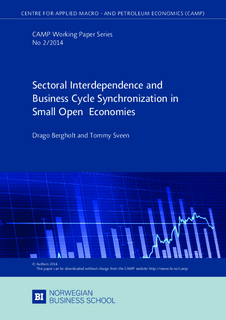| dc.description.abstract | Existing DSGE models are not able to reproduce the observed influence of international
business cycles on small open economies. We construct a two-sector New Keynesian model
to address this puzzle. The set-up takes into account intermediate trade and producer heterogeneity,
where goods and service industries differ in terms of i) price flexibility, ii) trade
intensity, iii) technology, iv) I-O structure, and v) the volatility of productivity innovations.
The combination of intermediate markets and heterogeneous producers makes international
business cycles highly important for the small economy, even if it has a large service sector.
Exploiting I-O matrices of Canadian and US industries, the model is able to reproduce the
role of international disturbances typically found in empirical studies. Model simulations
deliver cross-country correlations in macroeconomic variables of about 0:7, with half of the
variation in domestic variables attributed to foreign shocks. | nb_NO |
